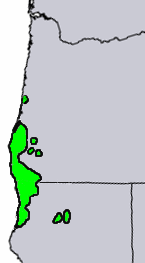John Muir called sugar pine the “King of the Pines.” It is the tallest of all the pines and can grow to over 200 feet. You can easily recognize it by its super long cones, which are longer than the cones of any other conifer, up to 20 inches long. Unlike the curved cones of western white pine, sugar pine cones are mostly straight. They have large seeds, but the seeds have large wings, so they can float long distances on the wind.
Sugar pine is primarily a California tree, growing throughout the mountains of the state. However, it has made inroads into the Cascades of Oregon. Some grow as far north as the Mount Hood National Forest, east of the Bull of the Woods Wilderness.
Sugar pine is a white pine with needles growing in bundles of five. The needles are bluish-green, with stomatal bloom on all three sides. Like other white pines native to the Pacific Northwest, it has been decimated by white pine blister rust. Fortunately, foresters have found trees that are resistant to the disease. Sadly, most of the large sugar pines were cut down for lumber by 1950.Sugar pine is named after the sweet resin that oozes from wounds to the tree. According to John Muir, the sap is better than maple sap. He thought Native Americans ate it but Aljos Farjon* notes that they chewed it like chewing gum. Note to anyone wanting to eat it: It is also a laxative. However, Native Americans did eat the seeds, which are as large as the seeds of the stone pines. You can buy stone pine seeds at your local grocery, where they are sold as pine nuts. They are tasty, but likely to deplete your bank account.
David Douglas gave sugar pine its scientific name, Pinus lambertiana, named after British botanist Aylmer Bourke Lambert. Following the directions of a Native American, Douglas found a sugar pine October 26, 1826 and wrote this account of that adventure in his journal:
The large trees are destitute of branches, generally for two-thirds the length of the tree; branches pendulous, and the cones hanging from their points like small sugar-loaves in a grocer’s shop, it being only on the very largest trees that cones are seen, and the putting myself in possession of three cones (all I could) nearly brought my life to an end. Being unable to climb or hew down any, I took my gun and was busy clipping them from the branches with ball when eight Indians came at the report of my gun. They were all painted with red earth, armed with bows, arrows, spears of bone, and flint knives, and seemed to me anything but friendly. I endeavoured to explain to them what I wanted and they seemed satisfied and sat down to smoke, but had no sooner done so than I perceived one string his bow and another sharpen his flint knife with a pair of wooden pincers and hang it on the wrist of the right hand, which gave me ample testimony of their inclination. To save myself I could not do by flight, and without any hesitation I went backwards six paces and cocked my gun, and then pulled from my belt one of my pistols, which I held in my left hand. I was determined to fight for life. As I as much as possible endeavoured to preserve my coolness and perhaps did so, I stood eight or ten minutes looking at them and they at me without a word passing, till one at last, who seemed to be the leader, made a sign for tobacco, which I said they should get on condition of going and fetching me some cones. They went, and as soon as out of sight I picked up my three cones and a few twigs, and made a quick retreat to my camp, which I gained at dusk.**
____________
See also
Sugar pine at Northwest Conifers
Conifers of the World, James Eckenwalder
*A Handbook of the World’s Conifers, Aljos Farjon
** Sugar pine at the Gymnosperm Database


















































